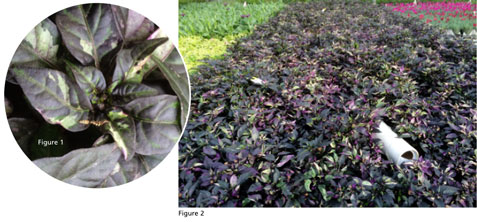6/29/2016
Innovations in Our BCA Usage
Roger McGaughey

A lot has been written in past articles about Pioneer Garden’s biological growing practices, but we’re still learning how to get the best out of all the BCAs available from our suppliers. Sometimes products don’t perform the way we expect, so we need to think outside the box, be innovative and find a solution to make them effective.
One case in point is aphid control. We grow a number of Purple Flash Pepper plants as part of our thrips control program. What have aphids got to do with thrips control? Well, all aspects of the growing process are inter-related, and as my assistant Amanda found out again this season, an aphid population on the pepper plants seems to be part of the mix.
Early this season when we first saw them, we tried several methods of aphid control without total success. As with any BCA usage, patience is a virtue, but at this juncture, I’ll pass the ball to Amanda to let her tell how we solved the problem:
“Scouting and record keeping proves to be especially important when we start our banker plants. We want to make sure we see the beneficial insects, but it also is important to make sure the banker plants are pest free. When it comes to transplanting our pepper plants, we almost always expect to find aphids. They seem to come out of nowhere, and we do not want to spray them and kill the Orius insidious we introduce onto the plants. This spring we tried several BCA options before we found one that worked.
“The first option that we tried to use to control the aphid population was lacewing. While they appeared to offer some control, and large larvae were seen on the growing tips of the pepper plants (Figure 1), the aphid repopulation rate was too fast for them to keep up. After the lacewing trial, our Biobest representative Doug Barrow suggested we try a plastic container with some holes cut in it for Aphidoletes application. The idea was that the container would serve as a place for the beneficials to reproduce and then fly out to control the aphids. Unfortunately, humidity built up too much in the plastic container and many Aphidoletes got stuck to the sides of the container and died.
By brainstorming a bit more, we came up with the idea of using the cardboard tubes that many beneficials, such as Atheta and Hypoaspis, arrive in as our introduction container. I cut semi-circular holes on either end of the tube in the plastic lids, added Aphidoletes and laid the tube on its side in the middle of the crop (Figure 2). The cardboard absorbed any water, so the beneficials did not get stuck. The Aphidoletes were able to fly out to find and control the aphid population. We started a new table using this method at the start of the second pepper crop and scouting for several weeks showed that we had, for the first time, produced a completely aphid-free crop of pepper bankers!”
By the time our first pepper crop was ready for transplanting into hanging baskets we still didn’t have complete control of the original aphid population. We were prepared to live with the lingering population, hoping that one of our other BCAs would finally control the aphids to a manageable level.
Aphid banker plants by this time were becoming well-established and our attention was diverted to the Aphidius population being reared on the cereal pots. We go on the theory that you can never have too many good predatory insects in-house, so we applied some Aphidius mix over the pepper baskets, as well as on the cereal bankers. As Amanda said earlier, scouting is all important, and it was with great glee that I recently found lots of aphid mummies under the leaves, near the shoot tips of the pepper banker hanging baskets (Figure 3).

Along with scouting, using yellow cards to indicate pest population levels is an extremely important practice to adopt. Some of the first insects that appear on yellow cards are fungus gnats and shore fly. With every new batch of soil mix that we place in the greenhouse, we’re automatically increasing the fungus gnat population. As with shore fly, these pests will increase, given moist conditions, under benches and on pathways. Our policy, even in our moist propagation department, is to dry up the floors as much as possible and eliminate breeding areas for unwanted pests. To this end, we apply cheap, pulverized lime to all pathways and areas under our benches (Figure 4). This, in conjunction with our weekly Citation sprays in the propagation department, results in almost clean yellow cards when scouted on our routine Monday inspection process.
We also routinely spray all of our greenhouse pathways, ebb/flood drains and table ends with Uptake to keep them free of algae and thus eliminate breeding areas for unwanted pests.
Currently in one greenhouse we’re increasing our banker plant numbers, as well as our dedicated line of banker hanging baskets and one table each of peppers and lobularia. More Orius equals fewer potential thrips.
This year, we plan, for the second time, to grow some banker plants in our bareroot field production areas. Pepper and lobularia plants complete with Orius and Mullein with Dicyphus are part of the banker mix that we’ll use in two of our fields (Figure 5).
This year, we’ll also use a range of pollinator plant species, which, hopefully, will increase the bee population and also give us a chance to evaluate some of the plant varieties that we ship to our customers. With minimal use of pesticides in those field production areas, we hope to attract some natural predators and keep an expected thrips population to a manageable level.
GT
Roger McGaughey, head grower at Pioneer Gardens in Deerfield, Massachusetts, was educated in Northern Ireland and England and has 40 years experience as a grower.